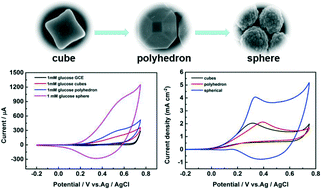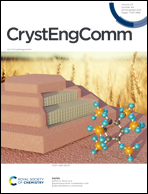Shape-controlled Cu2O nanospheres as bifunctional catalysts boosting the oxidations of glucose and hydrazine†
Abstract
Cuprous oxide (Cu2O) nanoparticles hold promise as low-cost catalysts for the oxidations of both glucose and hydrazine (N2H4), and their different geometrical shapes have been implied in literature to influence their catalytic activities. In this study, for the first time, a shape-controlled growth of the Cu2O crystals was achieved by the morphological evolution from nanocubes to nanopolyhedrons and then nanospheres. Subsequently, their catalytic performances were evaluated for the oxidations of glucose and hydrazine. With different catalytic activities observed, Cu2O nanospheres exhibited the best performance out of the three studied morphological shapes. The results showed that the Cu2O nanosphere-assembled electrode achieved boosting catalytic activities towards the oxidation of glucose with a high sensitivity of 3210 μA cm−2 Mm−1, a linear detection range of 1–1000 μM, a detection limit of 0.0163 μM and good selectivity. Moreover, the Cu2O nanosphere-assembled electrode also showed a low onset potential of −0.1 V, a high energy density of 4.1 mA cm−2 and a good stability towards the N2H4 oxidation. The characterization results indicated that a higher growth rate along the (111) over the (200) facet in nanosphere Cu2O crystals was in favor of their catalytic activities.

- This article is part of the themed collection: Nanomaterials


 Please wait while we load your content...
Please wait while we load your content...